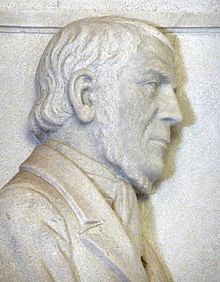Louis Tregardt
| Louis Tregardt | |
|---|---|

Relief of Tregardt in the Voortrekker Monument, Pretoria
|
|
| Born |
Louis Johannes Tregard 10 August 1783 Kango, Swellendam district |
| Died | 25 October 1838 (aged 55) Delagoa bay |
| Resting place |
Maputo 25°58′06″S 32°34′15.5″E / 25.96833°S 32.570972°E |
| Occupation | Field Cornet, farmer |
| Spouse(s) | Martha Elisabeth Susanna Bouwer (1796–1838) |
| Children |
Four reached maturity: |
| Parent(s) | Carolus (Carel) Johannes Tregard, Anna Elisabeth Nel |
Four reached maturity:
Carolus Johannes (1811-1901)
Petrus Frederik (1819-1860)
Louis Gustavus (1827-1891)
Louis Johannes Tregardt (10 August 1783 – 25 October 1838) (from Swedish: trädgård, garden) was a farmer from the Cape Colony's eastern frontier, who became an early voortrekker leader, called the "voorste mense". Shunning colonial authority, he emigrated in 1834 to live among the Xhosa, before he crossed the Orange River into neutral territory. His northward trek, along with fellow trekker Johannes (Hans) van Rensburg, was commenced in early 1836. He led his small party of emigrants, composed of seven Boer farmers, with their wives and thirty-four children, Bushman slaves and Bantu servants, into the uncharted interior of South Africa, and settled for a year at the base of the Zoutpansberg.
At this most northerly point of their trek, unhealthy conditions began to take a toll on man and animal. Seemingly abandoned by a follow-up trek, and distant from supplies and buyers for their ivory, Tregardt abandoned the settlement, and led the party southeastwards to the Portuguese outpost at Delagoa bay. The oceanward route proved arduous and included the challenge of traversing a section of the northern Drakensberg. Though reaching the fort at Delagoa bay, a number of their party contracted malaria en route. Tregardt's wife perished at the fort in May 1838, followed by Tregardt six months afterward.
Louis's father Carel was, as civilian officer, much involved in the 18th century Xhosa conflicts. In addition he was a participant in the Graaff-Reinet resistance movements, first against the Dutch East India Company and later against English colonial governance. For a time Louis farmed near Bruintjeshoogte (i.e. Somerset). He ostensibly had an uneasy relationship with the colonial authorities, and agreed to rent grazing land from Xhosa chief Hintsa.
...
Wikipedia
